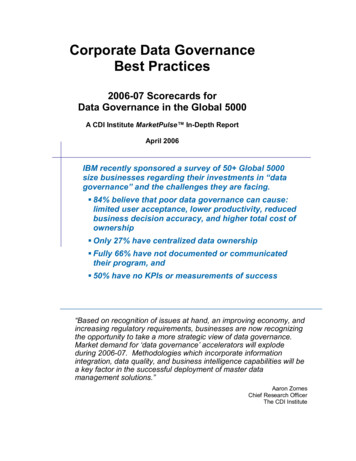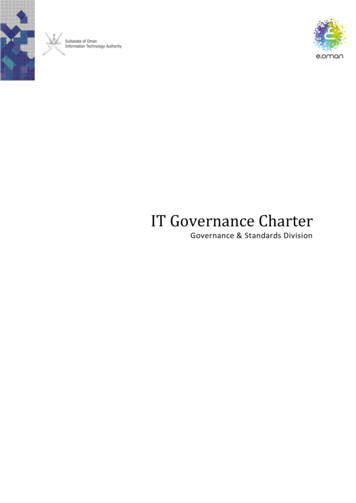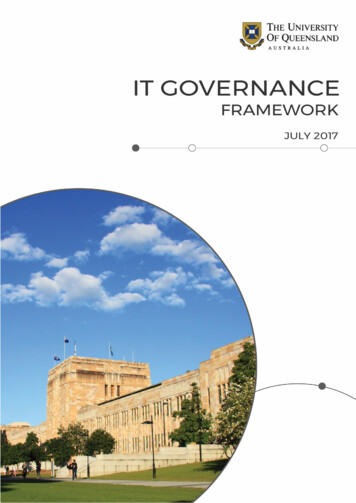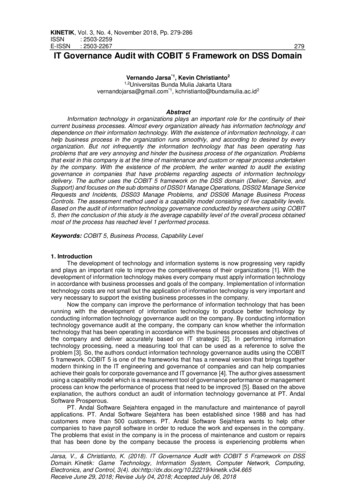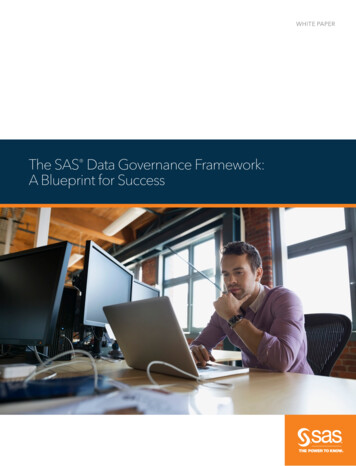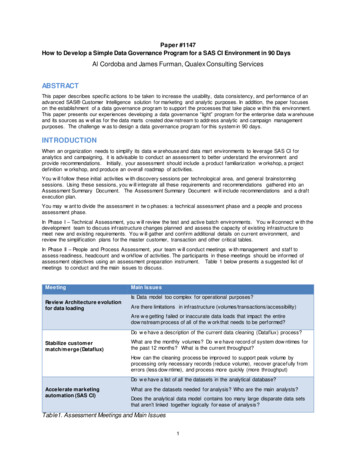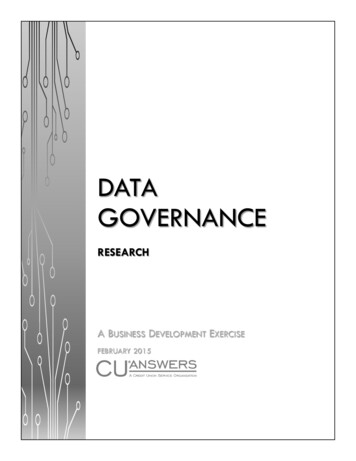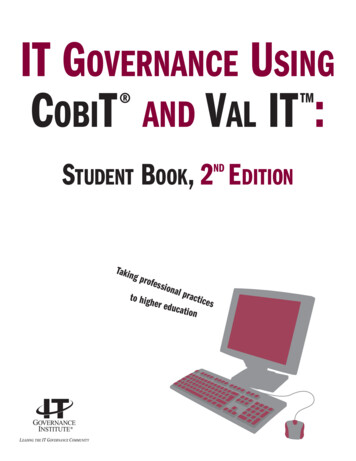
Transcription
IT GOVERNANCE USING COBIT AND VAL IT :TMNDSTUDENT BOOK, 2 EDITIONTakingp ro f et o h i ghs si o nal p rer edua ct i cca t i o nes
IT GOVERNANCE USING COBIT AND VAL ITTMSTUDENT BOOK, 2 EDITIONNDIT Governance Institute The IT Governance Institute (ITGITM) (www.itgi.org) was established in 1998 to advance international thinking and standards indirecting and controlling an enterprise’s information technology. Effective IT governance helps ensure that IT supports businessgoals, optimises business investment in IT, and appropriately manages IT-related risks and opportunities. ITGI offers originalresearch and case studies to assist enterprise leaders and boards of directors in their IT governance responsibilities.DisclaimerITGI and the author of IT Governance Using COBIT and Val ITTM: Student Book, 2nd Edition have designed the publication primarilyas an educational resource for educators. ITGI, ISACA and the authors make no claim that use of this product will assure asuccessful outcome. The publication should not be considered inclusive of all proper procedures and tests or exclusive of all properprocedures and tests that are reasonably directed to obtaining the same results. In determining the propriety of any specific procedureor test, controls professionals should apply their own professional judgement to the specific control circumstances presented by theparticular systems or IT environment. Note that this publication is an update of COBIT in Academia: Student Book.Disclosure 2007 IT Governance Institute. All rights reserved. This publication is intended solely for academic use and shall not be used in anyother manner (including for any commercial purpose). Reproductions of selections of this publication are permitted solely for the usedescribed above and must include the following copyright notice and acknowledgement: ‘Copyright 2007 IT Governance Institute.All rights reserved. Reprinted by permission.’ IT Governance Using COBIT and Val ITTM: Student Book, 2nd Edition may nototherwise be used, copied or reproduced, in any form by any means (electronic, mechanical, photocopying, recording or otherwise),without the prior written permission of ITGI. Any modification, distribution, performance, display, transmission or storage, in anyform by any means (electronic, mechanical, photocopying, recording or otherwise) of IT Governance Using COBIT and Val ITTM:Student Book, 2nd Edition is strictly prohibited. No other right or permission is granted with respect to this work.IT Governance Institute3701 Algonquin Road, Suite 1010Rolling Meadows, IL 60008 USAPhone: 1.847.590.7491Fax: 1.847.253.1443E-mail: info@itgi.orgWeb site: www.itgi.orgISBN 978-1-60420-024-9IT Governance Using COBIT and Val ITTM: Student Book, 2nd EditionPrinted in the United States of AmericaIT GOVERNANCE INSTITUTE
ACKNOWLEDGEMENTSACKNOWLEDGEMENTSITGI wishes to recognise:ResearcherEd O’Donnell, University of Kansas, USAContributorsRoger Stephen Debreceny, Ph.D., FCPA, University of Hawaii, USASteven DeHaes, University of Antwerp Management School, BelgiumErik Guldentops, CISA, CISM, University of Antwerp Management School, BelgiumRobert Parker, CISA, CA, CMC, FCA, CanadaV. Sambamurthy, Ph.D., Michigan State University, USAScott Lee Summers, Ph.D., Brigham Young University, USAJohn Thorp, The Thorp Network, CanadaWim Van Grembergen, Ph.D., University of Antwerp (UA) and University of Antwerp Management School (UAMS)and IT Alignment and Governance Research Institute (ITAG), BelgiumRamesh Venkataraman, Ph.D., Indiana University, USAITGI Board of TrusteesEverett C. Johnson, CPA, Deloitte & Touche (retired), USA, International PresidentGeorges Ataya, CISA, CISM, CISSP, ICT Control sa-nv, Belgium, Vice PresidentWilliam C. Boni, CISM, Motorola, USA, Vice PresidentLucio Augusto Molina Focazzio, CISA, Colombia, Vice PresidentAvinash Kadam, CISA, CISM, CBCP, CISSP, Miel e-Security Pvt. Ltd., India, Vice PresidentJean-Louis Leignel, MAGE Conseil, France, Vice PresidentHoward Nicholson, CISA, City of Salisbury, Australia, Vice PresidentFrank Yam, CISA, CIA, CCP, CFE, CFSA, FFA, FHKCS, FH KIoD, Focus Strategic Group, Hong Kong, Vice PresidentMarios Damianides, CISA, CISM, CA, CPA, Ernst & Young LLP, USA, Past International PresidentRobert S. Roussey, CPA, University of Southern California, USA, Past International PresidentRonald Saull, CSP, Great-West Life Assurance and IGM Financial, Canada, TrusteeIT Governance CommitteeTony Hayes, FCPA, Queensland Government, Australia, ChairMax Blecher, Virtual Alliance, South AfricaSushil Chatterji, SingaporeAnil Jogani, CISA, FCA, Tally Solutions Limited, UKJohn W. Lainhart, IV, CISA, CISM, CIPP/G, IBM, USARomulo Lomparte, CISA, Banco de Credito BCP, PeruMichael Schirmbrand, Ph.D., CISA, CISM, CPA, KPMG LLP, AustriaRonald Saull, CSP, Great-West Life Assurance and IGM Financial, CanadaITGI Advisory PanelRonald Saull, CSP, Great-West Life Assurance and IGM Financial, Canada, ChairRoland Bader, F. Hoffmann-La Roche AG, SwitzerlandLinda Betz, IBM Corporation, USAJean-Pierre Corniou, Renault, FranceRob Clyde, CISM, Symantec, USARichard Granger, NHS Connecting for Health, UKHoward Schmidt, CISM, R&H Security Consulting LLC, USAAlex Siow Yuen Khong, StarHub Ltd., SingaporeAmit Yoran, Yoran Associates, USAIT GOVERNANCE INSTITUTE
IT GOVERNANCE USING COBIT AND VAL ITTMSTUDENT BOOK, 2 EDITIONNDACKNOWLEDGEMENTS (CONT.)Academic Relations CommitteeScott Lee Summers, Ph.D., Brigham Young University, USA, ChairCasey G. Cegielski, Ph.D., CISA, Auburn University, USAPatrick Hanrion, CISM, CISSP, CNE, MCSE, Microsoft, USADonna Hutcheson, CISA, XR Group Inc., USACejka Jiri Josef, CISA, Dipl. El. -Ing., KPMG Fides Peat, SwitzerlandMichael Lambert, CISA, CISM, CARRA, CanadaEd O’Donnell, University of Kansas, USATheodore Tryfonas, Ph.D., CISA, University of Glamorgan, WalesRamesh Venkataraman, Ph.D., Indiana University, USACOBIT Steering CommitteeRoger Stephen Debreceny, Ph.D., FCPA, University of Hawaii, USA, ChairGary S. Baker, CA, Deloitte & Touche, CanadaSteven DeHaes, University of Antwerp Management School, BelgiumRafael Eduardo Fabius, CISA, Republica AFAP, S.A., UruguayUrs Fischer, CISA, CIA, CPA (Swiss), Swiss Life, SwitzerlandErik Guldentops, CISA, CISM, University of Antwerp Management School, BelgiumGary Hardy, IT Winners, South AfricaJimmy Heschl, CISM, CISA, KPMG, AustriaDebbie A. Lew, CISA, Ernst & Young LLP, USAMaxwell J. Shanahan, CISA, FCPA, Max Shanahan & Associates, AustraliaDirk E. Steuperaert, CISA, PricewaterhouseCoopers LLC, BelgiumRobert E. Stroud, CA Inc., USAITGI Affiliates and SponsorsISACA chaptersAmerican Institute for Certified Public AccountantsASIS InternationalThe Center for Internet SecurityCommonwealth Association of Corporate Governance Inc.FIDA InformInformation Security ForumInformation Systems Security AssociationInstitut de la Gouvernance des Systèmes d’InformationInstitute of Management AccountantsISACAITGI JapanSolvay Business SchoolUniversity of Antwerp Management SchoolAldion Consulting Pte. Ltd.CAHewlett-PackardIBMITpreneurs Nederlands BVLogLogic Inc.Phoenix Business and Systems Process Inc.Project Rx Inc.Symantec CorporationWolcott Group LLCWorld Pass IT SolutionsIT GOVERNANCE INSTITUTE
TABLE OF CONTENTSTABLE OF CONTENTS1. Purpose of This Document.22. Governing IT Resources.3What Is IT Governance?.3Why Is IT Governance Important? .3What Does IT Governance Cover? .4Conclusion .103. Managing IT Risks .11The COBIT Framework .11Conclusion .164. Providing IT Assurance.17Assurance Planning .18Defining the Scope of the Assurance Initiative .18Assurance Initiative Execution.19Examples of the Use of Detailed Assurance Steps.22Conclusion .235. Auditing IT Controls Over Financial Reporting .24IT Control Environment .24Computer Operations.24Access to Programs and Data.24Program Development and Program Change .25The Audit Process.25Conclusion.31Appendix—COBIT Components for Five Processes .32COBIT Framework Navigation.32DS2 COBIT Components With Additional Guidance .33PO9 COBIT Components .44AI2 COBIT Components .52DS5 COBIT Components .65ME2 COBIT Components .81COBIT and Related Products.90IT GOVERNANCE INSTITUTE1
IT GOVERNANCE USING COBIT AND VAL ITTMSTUDENT BOOK, 2 EDITIONND1. PURPOSE OF THIS DOCUMENTThe goal of IT Governance Using COBIT and Val ITTM: Student Book, 2nd Edition, is to provide high-quality educational material thatcan be integrated into courses on information systems, management control or assurance services. This document provides overviews of: IT governance The Control Objectives for Information and related Technology (COBIT ) framework for IT controls IT assurance initiatives Audits of IT controls over financial reportingThe Student Book, 2nd Edition, was developed by ITGI, in collaboration with a group of international academics and practitioners, byassembling excerpts from other ITGI publications.The objective in creating this document was to develop a learning resource that can be used effectively by students with little or nobusiness experience. As a result, the ITGI materials reproduced herein have been abridged by removing material that addresses practicaland operational issues that are of concern to business people and information technology (IT) professionals, but may be difficult forstudents to appreciate and comprehend.Chapter 2, Governing IT Resources, describes IT governance practices and how an organisation can create business value through ITinvestments. Material for chapter 2 was assembled from the Board Briefing on IT Governance, 2nd Edition and Enterprise Value:Governance of IT Investments—The Val IT Framework. Students will learn how organisations manage IT resources to deliverstakeholder value through strategic alignment, value delivery, risk management and performance measurement. This chapter alsodescribes how organisations can manage their IT investments as a portfolio.Chapter 3, Managing IT Risks, presents a framework of control objectives designed to help an organisation manage risks that threateninformation and related technology. Material for chapter 3 was assembled from COBIT 4.1. Students will learn how to establish controlobjectives for planning and organising the IT function, acquiring and implementing IT capabilities, delivering and supporting ITfunctions, and monitoring and evaluating IT service delivery. This chapter also discusses the role of IT application controls in a riskmanagement initiative.Chapter 4, Providing IT Assurance, describes the processes that assurance professionals use to evaluate and report on the effectiveness ofIT controls. Material for chapter 4 was assembled from the IT Assurance Guide Using COBIT . Students will learn how to develop aplan for IT assurance initiatives, scope the initiative by identifying key control objectives, and test the design and operating effectivenessof control procedures designed to address key control objectives. This chapter also provides examples of how to test the design andoperating effectiveness of IT controls, and evaluate the impact of control weaknesses.Chapter 5, Auditing IT Controls Over Financial Reporting, outlines the process for auditing IT controls over financial reporting.Material for chapter 5 was assembled from IT Control Objectives for Sarbanes-Oxley, 2nd Edition. Students will learn about the processfor auditing IT general controls over financial reporting, including how to plan and scope an evaluation, assess IT risk, document ITcontrols, evaluate the design and operating effectiveness of IT controls, and build sustainability into the evaluation process.2IT GOVERNANCE INSTITUTE
GOVERNING IT RESOURCES2. GOVERNING IT RESOURCESIncreasingly, top management is realising the significant impact that IT can have on the success of the enterprise. Management hopes forheightened understanding of the way IT is operated and the likelihood of its being leveraged successfully for competitive advantage.Boards and executive management need to extend governance to IT and provide the leadership, organisational structures and processesthat ensure that the enterprise’s IT sustains and extends the enterprise’s strategies and objectives. IT governance is not an isolateddiscipline; it is an integral part of overall enterprise governance.The need to integrate IT governance with overall governance is similar to the need for IT to be an integral part of the enterprise ratherthan something practiced in remote corners or ivory towers. An increasingly educated and assertive set of stakeholders is concernedabout the sound management of its interests. This has led to the emergence of governance principles and standards for overall enterprisegovernance. Furthermore, regulations establish board responsibilities and require that the board of directors exercise due diligence in itsroles. Investors have also realised the importance of governance; research shows they are willing to pay a premium of more than 20percent on shares of enterprises that have shown to have good governance practices in place.1Enterprise governance is a set of responsibilities and practices exercised by the board and executive management with the goal ofproviding strategic direction, ensuring that objectives are achieved, ascertaining that risks are managed appropriately and verifying thatthe enterprise’s resources are used responsibly. While governance developments have primarily been driven by the need for thetransparency of enterprise risks and the protection of shareholder value, the pervasive use of technology has created a criticaldependency on IT that calls for a specific focus on IT governance.IT is essential to manage the transactions, information and knowledge necessary to initiate and sustain economic and social activities. Inmost enterprises, IT has become an integral part of the business and is fundamental to support, sustain and grow the business.Successful enterprises understand and manage the risks and constraints of IT. Increasingly, boards of directors understand the strategicimportance of IT and have put IT governance firmly on their agenda.WHAT IS IT GOVERNANCE?The overall objective of IT governance is to understand the issues and strategic importance of IT so the enterprise can sustain itsoperations and implement the strategies required to extend its activities into the future. IT governance aims to ensure that expectationsfor IT are met and IT risks are mitigated. IT governance is the responsibility of the board of directors and executive management. It is anintegral part of enterprise governance and consists of the leadership and organisational structures and processes that ensure that theorganisation’s IT sustains and extends the organisation’s strategies and objectives.At the heart of the governance responsibilities of setting strategy, managing risks, delivering value and measuring performance are thestakeholder values, which drive the enterprise and IT strategy. Sustaining the current business and growing into new business modelscertainly are stakeholder expectations, and can be achieved only with adequate governance of the enterprise’s IT infrastructure.The purpose of IT governance is to direct IT endeavors, to ensure that IT’s performance meets the following objectives: Alignment of IT with the enterprise and realisation of the promised benefits Use of IT to enable the enterprise by exploiting opportunities and maximising benefits Responsible use of IT resources Appropriate management of IT-related risksWHY IS IT GOVERNANCE IMPORTANT?The use of IT has the potential to be the major driver of economic wealth in the 21st century. Whilst IT is already critical to enterprisesuccess, provides opportunities to obtain a competitive advantage and offers a means for increasing productivity, it will do all this to aneven greater extent in the future. Successfully leveraging IT to transform the enterprise and create value-added products and services hasbecome a universal business competency. IT is fundamental for managing enterprise resources, dealing with suppliers and customers,and enabling increasingly global transactions.1McKinsey’s Investors Opinion Survey, June 2000IT GOVERNANCE INSTITUTE3
IT GOVERNANCE USING COBIT AND VAL ITTMSTUDENT BOOK, 2 EDITIONNDIT also is key for recording and disseminating business knowledge. An ever larger percentage of the market value of enterprises hastransitioned from the tangible (inventory, facilities, etc.) to the intangible (information, knowledge, expertise, reputation, trust, patents,etc.). Many of these assets revolve around the use of IT. Moreover, a firm is inherently fragile if its value emanates more fromconceptual, rather than physical, assets.Therefore, good governance of IT is critical in supporting and enabling enterprise goals. Whilst IT is fundamental to sustain what maybe unglamorous and taken-for-granted business operations, it is equally essential for business growth and innovation. Those with a strictcommercial focus may challenge the latter but should be aware that unwillingness to innovate limits the prospects of achieving futuregoals and long-term sustainability.IT also carries risks. It is clear that, in these days of doing business on a global scale and around the clock, system and networkdowntime has become far too costly for any enterprise. In some industries, IT is a necessary competitive resource to differentiate andprovide a competitive advantage, whilst in many others it determines not just prosperity but survival. The networked economy hasbrought more efficient markets, enabled streamlining of processes and optimised supply chains. It has also created new technology andbusiness risks and new information and resilience requirements. These new requirements and risks mandate that management of IT bemore effective and transparent.WHAT DOES IT GOVERNANCE COVER?Fundamentally, IT governance is concerned about two things: IT’s delivery of value to the business and the mitigation of IT risks. Thefirst is driven by strategic alignment of IT with the business. The second is driven by embedding accountability into the enterprise. Bothneed to be supported by adequate resources and measured to ensure that the results are obtained.IT governance is also a process through which the IT strategy drives the IT processes, which obtain resources necessary to execute theirresponsibilities. The IT processes report against these responsibilities on process outcome, performance, risks mitigated and accepted,and resources consumed. These reports should either confirm that the strategy is properly executed or provide indications that strategicredirection is required.This leads to the five main focus areas for IT governance, all driven by stakeholder value. Two of them are outcomes: value delivery andrisk management. Three of them are drivers: strategic alignment, resource management (which overlays them all) and performancemeasurement. These associations are illustrated in figure 1.Figure 1—Focus Areas of IT GovernanceIT ResourceManagementIT riversRiskManagementPerformanceMeasurement4IT GOVERNANCE INSTITUTE
GOVERNING IT RESOURCESIT governance is also a continuous life cycle that can be entered at any point. Usually one starts with the strategy and its alignmentthroughout the enterprise. Then implementation occurs, delivering the value the strategy promised and addressing the risks that needmitigation. At regular intervals (some recommend continuously), the strategy needs to be monitored and the results measured, reportedand acted upon. Generally on an annual basis, the strategy is re-evaluated and realigned, if needed. This life cycle does not take place ina vacuum. Each enterprise operates in an environment that is influenced by: Stakeholder values The mission, vision and values of the enterprise The community and company ethics and culture Applicable laws, regulations and policies Industry practicesStrategic AlignmentTo be aligned, an enterprise’s investment in IT must be in harmony with its strategic objectives (intent, current strategy and enterprisegoals) to build the capabilities necessary to deliver business value. This state of harmony is referred to as ‘alignment’. It is complex,multifaceted and never completely achieved. It is about continuing to move in the right direction and being better aligned thancompetitors. This may not be attainable for many enterprises because enterprise goals change too quickly, but it is nevertheless aworthwhile ambition because there is real concern about the value of IT investment.Alignment of IT has been synonymous with IT strategy, i.e., does the IT strategy support the enterprise strategy? For IT governance,alignment encompasses more than strategic integration between the (future) IT organisation and the (future) enterprise organisation. Italso is about whether IT operations are aligned with the current enterprise operations. The IT strategy articulates the enterprise’sintention to use IT for some or all of these reasons, based on business requirements. Linkage to the business aims is essential for IT todeliver recognisable value to the enterprise.When formulating the IT strategy, management must consider business objectives; the competitive environment; and current and futuretechnologies, including the costs, risks and benefits they can bring to the business. Management must also consider the capability of theIT organisation to deliver current and future levels of service to the business, and the extent of change and investment this might implyfor the whole enterprise.It is important that the plan for implementing the strategy be endorsed by all relevant parties. It is also important that the implementationplans be broken down into manageable parts, each with a clear business case incorporating a plan for achieving outcomes and realisingbenefits. The board should ensure that the strategy is reviewed regularly in light of technological and operational change.Value DeliveryThe basic principles of IT value are the on-time and within-budget delivery of appropriate quality, which achieves the benefits that werepromised. In business terms, this is often translated into competitive advantage, elapsed time for order/service fulfillment, customersatisfaction, customer wait time, employee productivity and profitability. Several of these elements are either subjective or difficult tomeasure, something all stakeholders need to understand. Often, top management and boards fear to start major IT investments becauseof the size of investment and the uncertainty of the outcome. For effective IT value delivery to be achieved, both the actual costs and thereturn on investment (ROI) need to be managed.The value that IT adds to the business is a function of the degree to which the IT organisation is aligned with the business and meets theexpectations of the business. The business should set expectations relative to the contents of the IT deliverable. To manage theseexpectations, IT and the business should use a common language for value, which translates business and IT terminology and is basedwholly on fact.Different levels of management and users perceive the value of IT differently—the higher one goes in the measurement hierarchy, themore dilution occurs (i.e., the less influence IT management can exercise). This also means that measuring the impact of an ITinvestment is much easier at the bottom of the hierarchy than at the top. However, successful investments in IT have a positive impact onall four levels of the business value hierarchy.IT GOVERNANCE INSTITUTE5
IT GOVERNANCE USING COBIT AND VAL ITTMSTUDENT BOOK, 2 EDITIONNDIT needs to be aligned to deliver value so that it supports the enterprise as it is by delivering on time, with appropriate functionality andachievement of the intended benefits. Alignment of IT also provides value by delivering infrastructures that enable the enterprise to growby breaking into new markets, increasing overall revenue, improving customer satisfaction, assuring customer retention and drivingcompetitive strategies.To be successful, enterprises need to be aware that different strategic contexts require different indicators of value. This means that it isimportant to establish the value measures in concert between the business and IT. It should also be mentioned that the public sector hasdifferent value drivers/indicators than the private sector. In the public sector, measures such as compliance and due diligence takeprominence over financial measures, such as profitability.Risk ManagementEnterprise risk comes in many varieties in addition to financial risk. Regulators are specifically concerned about operational andsystemic risk, within which technology risk and information security issues are prominent. Infrastructure protection initiatives point tothe complete dependence of all enterprises on IT infrastructures and the vulnerability to new technology risks.The board should manage en
IT GOVERNANCE I NSTITUTE ITGOVERNANCE USING COBIT AND VAL IT TM STUDENT BOOK, 2 ND EDITION IT Governance Institute The IT Governance Institute (ITGITM) (www.itgi.org) was established in 1998 to advance international thinking and standards in directing and controlling an enterprise’s infor

